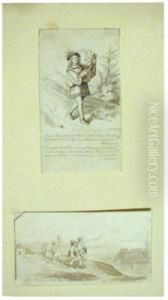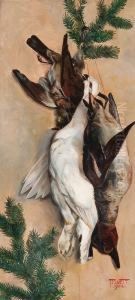Moritz Veith Paintings
Moritz Veith was an Austro-Hungarian painter known for his contributions to landscape and genre painting. Born in 1863 in the vibrant city of Vienna, which was then the capital of the Austro-Hungarian Empire, Veith grew up during a period rich with cultural and artistic activity. The late 19th century was a time when Vienna was a hub for intellectuals, artists, and musicians, and it provided a stimulating environment for Veith's artistic development.
Veith's early life and education remain relatively undocumented, but like many artists of his era, he likely received formal training at an institution such as the Academy of Fine Arts Vienna. This would have provided him with a foundation in the techniques and styles prevalent in European art at the time. He would have been exposed to various movements such as Romanticism, Realism, and the beginnings of Modernism, which would go on to influence his work.
Throughout his career, Veith developed a reputation for his evocative landscapes and genre scenes. His work often captured the essence of rural life and the natural beauty of the countryside, reflecting a Romantic sensibility towards nature. He painted with a keen eye for detail and a palette that emphasized naturalistic colors and tones.
Moritz Veith's contributions to art were recognized in his time, and he exhibited his work in various galleries and salons. His paintings were collected by enthusiasts of Austro-Hungarian art and can be found in private collections and possibly in regional museums today. Despite this, Veith, like many artists of the period, did not gain the same level of lasting fame as some of his contemporaries. As a result, detailed records of his life and work are scarce, and his legacy lives on primarily through the paintings that survive him.
Moritz Veith passed away in 1930, leaving behind a body of work that offers a window into the Austro-Hungarian Empire's landscape and social milieu. While not a household name, his paintings continue to be appreciated by art historians and collectors who have an interest in the period.

